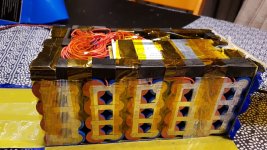Cuprani
100 mW
- Joined
- Jan 14, 2019
- Messages
- 39
I recently bought a custom build vector with a broken Ali Express battery.
It's a 72V 20S4P 26650 pack, so the battery contains 80 pieces of 26650 cells.
The cells have no text on them at all, so I don't have any specs.
Probably the cheapest cells available.
The problem with my 6kW bike is that the voltage dropped below 60V with only 25% throttle.
I could ride the bike when fully charged, but only if I were very gentile on the throttle. After a while I couldn't even look at the throttle without the controller limping into safe mode and shut down the bike.
In order to fix the problem I dismantled the battery. I've measured an average voltage of every pack of about 3,6V, but found 1 pack that only had 2,8V.

I extracted it from the battery, and when I did a full recovery cycle for those four cells, one cell was only able to store 200 mah while the other 3 were around 3500 mah.
View attachment 4
I've tested the 4 cells of the broken pack separately under load in order to have something to compare to.
View attachment 2
And I've tested the first 11 series of the battery under load (I didn't want to dismantle the other half of the battery for now, only tested half of the battery)
View attachment 1
Here are the results
(*The battery pack wasn't fully charged, but the separate battery's were)
Questions
- Are these normal figures under these kind of loads?
- Is there anyone that can explain why my voltage is higher under 10A of load then under 5A of load?
- Is it better to replace one cell, and combine it with the other 3 to make a new parallel pack? (this way the four battery's will level out and it won't have a huge affect when the internal resistance of the new cell is a little different. The cons are that the other 3 cells probably are damaged as well because the voltage of this pack was way lower then the rest.)
- Or is it better to place 4 new cells in this pack (with the chance that it has another internal resistance which will cause the BMS to have a hard time to balance the battery)
I know this battery pack will never give me top notch results, but I'll hope I can get it restored cheap while I'm still building and testing my bike.
It's a 72V 20S4P 26650 pack, so the battery contains 80 pieces of 26650 cells.
The cells have no text on them at all, so I don't have any specs.
Probably the cheapest cells available.
The problem with my 6kW bike is that the voltage dropped below 60V with only 25% throttle.
I could ride the bike when fully charged, but only if I were very gentile on the throttle. After a while I couldn't even look at the throttle without the controller limping into safe mode and shut down the bike.
In order to fix the problem I dismantled the battery. I've measured an average voltage of every pack of about 3,6V, but found 1 pack that only had 2,8V.

I extracted it from the battery, and when I did a full recovery cycle for those four cells, one cell was only able to store 200 mah while the other 3 were around 3500 mah.
View attachment 4
I've tested the 4 cells of the broken pack separately under load in order to have something to compare to.
View attachment 2
And I've tested the first 11 series of the battery under load (I didn't want to dismantle the other half of the battery for now, only tested half of the battery)
View attachment 1
Here are the results
(*The battery pack wasn't fully charged, but the separate battery's were)
Questions
- Are these normal figures under these kind of loads?
- Is there anyone that can explain why my voltage is higher under 10A of load then under 5A of load?
- Is it better to replace one cell, and combine it with the other 3 to make a new parallel pack? (this way the four battery's will level out and it won't have a huge affect when the internal resistance of the new cell is a little different. The cons are that the other 3 cells probably are damaged as well because the voltage of this pack was way lower then the rest.)
- Or is it better to place 4 new cells in this pack (with the chance that it has another internal resistance which will cause the BMS to have a hard time to balance the battery)
I know this battery pack will never give me top notch results, but I'll hope I can get it restored cheap while I'm still building and testing my bike.

